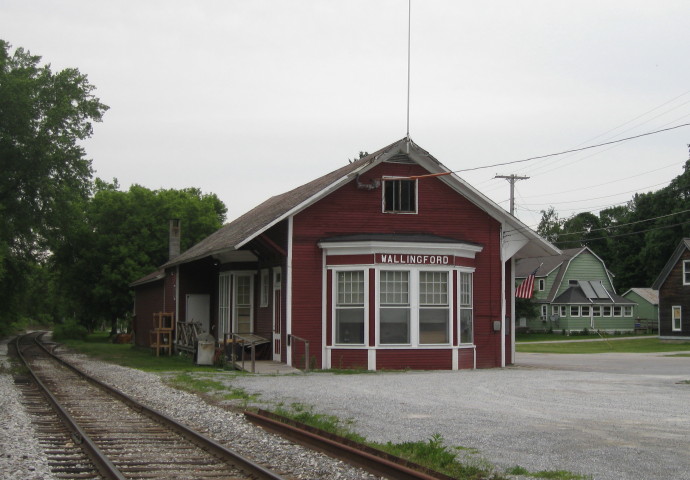`
by
Robin Bowers
Text and Photos by Author
Our first morning in Vermont began shortly
after 6:00 AM as we headed for the Day's Inn breakfast room. A
cozy room with windows over looking the front yard. There were the
usual breakfast fixings to be had. The most popular spot was the
do it yourself waffle iron. Of course, I had to make myself one.
That and some juice, yogurt and coffee made for my breakfast.
After breakfast, Chris and I drove to the
meeting place to board our train today. We arrived at 6:30 AM and
meet with several early arrivals. Shuttle buses starting running
from the hotel at 6:00AM. Our train will depart Howe Center at
Rutland at 7:00 AM.
The mansard roof style is popular in the area.
MP 52.48 Rutland - This
location is the current Amtrak station in Rutland, based upon the
mileposts of the Bellows Falls Subdivision.
MP 52.0 Howe Scale
Avenue - This was the main entrance to the Howe Scale industrial
complex.
The Howe Scale company moved to Rutland at the
encouragement of J. B. Page, former Vermont governor and a
director of the Rutland & Burlington Railroad. Page was a
partner of Nathan T. Sprague, Jr., owner of the Sampson Scale
Company, the manufacturer of Howe Scales. After the firm's plant
burned down, the company moved much of its manufacturing to this
location in 1876. The scale factory was built using the name of
Howe Scales. The plant was very successful, and eventually became
the Howe Richardson Scale Works, once the largest platform scale
manufacturers in the world. At its peak, Howe operated three
shifts around the clock, producing up to four million pounds of
castings annually and shipping tens of millions of dollars' worth
of finished goods, making it the second largest industrial scale
maker in the world.
After the facility closed in 1982, it
eventually became the Howe Center, an 18-acre mixed use industrial
complex.Howe Center includes 24 buildings and over 300,000 square
feet of leas-able space. Reports indicate that there are more than
75 different tenants with uses covering the gamut from one-room
offices to large manufacturers.
pic
Our train ride for today. #405 is the sister of
#401 which pulled us in Kingston yesterday.
The freight cars are empty's which will be drop off in Smithville,
VT and we will return with just the passenger cars.
When speaking of Rutland, Vermont, you must be careful of knowing if you are talking about the Town of Rutland, or the City of Rutland. The original Town of Rutland was chartered in 1761 by Governor Benning Wentworth after John Manners, 3rd Duke of Rutland. The first true community in the area was Mill Village, located on Otter Creek and created in the early 1800s. Mill Village benefited from the discovery of several small deposits of high-quality marble, and developers began searching throughout the area for larger deposits. During the 1830s, a much larger deposit was discovered in what is now West Rutland. With the arrival of the railroads in 1851, major marble developments began, becoming one of the major sources of the material worldwide. Mill Village/Rutland supplied the community with flour and cut lumber from its grist and saw mills.
The growth of the Town of Rutland caused problems that came to a head in the 1880s when it was proposed to divide the settlement into smaller units. In 1886, the split became official when two new towns - West Rutland and Proctor - broke off from the Town of Rutland. This removed the marble quarries and mill areas to the north and west from what is today downtown Rutland. While most of the marble wasn't in Rutland, its location at the junction of several rail lines made it the supply center of the industry, and Rutland Village was incorporated in 1886. With more growth, on November 18, 1892, Rutland City was incorporated as Vermont's third city, dividing the area into the two parts - the Town of Rutland and the City of Rutland.
During the early part of the 20th Century, Rutland boomed as an industrial and trade community. Warehouses lined many of the streets, and the neighborhoods showed the available wealth with a large number of traditional Victorian homes. Rutland also served as the county seat, bringing with it the courthouse and legal activities such as law offices. Today, many of these buildings still exist and the downtown area of the city is listed as a historic district on the National Register of Historic Places.
A reminder of this industrialization is a historical marker in town. The marker notes the birth of John Deere in Rutland on February, 7th, 1804. He was born over William Deere's tailor shop located on the east side of Main Street Park. A year later the family moved to Middlebury and then John Deere moved to Illinois in 1836 where he began making his famous plows.
Besides the marble companies and railroad, Rutland's other major employer was the Howe Scale Company, whose headquarters complex was located south of the rail yard on what is now Scale Avenue. At its height toward the end of the nineteenth century, the workshops employed more than 500 skilled workers.
The late 1900s were not kind to Rutland. Many of the marble quarries closed in the 1980s and 1990s as substitute materials took over in the construction market. Many of the local factories closed, and Rutland actually saw a decrease in population. However, there have been successes. For example, the Town of Rutland was the first Vermont Town to establish a web presence when it launched this site in February 1996. Rutland also began to benefit from tourism, thanks to the nearby Killington ski area. The surrounding mountains have also brought in the summer tourist. To the west are the Taconic Mountains and the Lake Champlain region. To the east are the Green Mountains, with a chain of mountains approaching or exceeding 4000 feet in elevation. Today, the City of Rutland has just under 20,000 residents and is the third largest city in Vermont.
The Rutland Railroad was named for this city and maintained its headquarters and major facilities here. When looking at a map of the City of Rutland, the rail routes make the reasons very obvious. Tracks head in four different directions, and there have never been any major route abandonments. Tracks head north to Burlington, west to Whitehall, south to Bennington, and southeast to Bellows Falls. Being built during the mid-1800s, all of the routes chose the easiest grades for construction, and later built highways have followed the same general routes. All of the railroads, and highways, come together near downtown Rutland.
In 1843, the state legislature chartered the Champlain & Connecticut River Railroad to connect Rutland and Burlington. In 1847, the company changed its name to the Rutland & Burlington Railroad even before construction had begun. By December 1848, the railroad was completed from Bellows Falls to Rutland and on north to Burlington on Lake Champlain. This route created a solid rail link to the port at Boston, and made Rutland an important terminal on the railroad. Also arriving in Rutland was the Bennington & Rutland, and the Rutland & Washington Railroads.
Construction of various rail facilities began at Rutland soon after. Reports indicate that soon there were several roundhouses, a station, and a number of other facilities in the city. With the consolidation of the Rutland & Burlington and the Bennington & Rutland, Rutland became the centralized shops and facilities for the Rutland Railroad. At one time, this included a passenger station, roundhouse and backshop, rail yard, and almost every other facility needed by a railroad. Unfortunately, today's Rutland railroad scene is just a shadow of those days. The Rutland Plaza Shopping Center, located just east of the current Amtrak station, basically fills the space of the original Rutland Railroad yards and shops.
The Rutland yard and shops area went through four major eras. The first was the initial construction era of the 1850s and 1860s. During this time, the railroads were being completed and new routes were being created. The second era dates from 1890 to 1920 when the Rutland Railroad went through a modernization program, adding new and enlarged shops. The third era was the steam to diesel transition when facilities were closed. The final era was the removal of most of the yard and facilities, replaced by a shopping center.
The original rail yard at Rutland established a setting that was unchanged for a century. Established in the early 1850s, the yard started where the lines from Bellows Falls and Bennington came together, protected by a set of ball signals. During the late 1800s, there was a small wooden gallows turntable to the west of the signal. From here, the railroad passed north under River Street. By the 1920s, the yard had two ice houses to the west of the mainline, where the tracks split with one main track looping to the west and a number of tracks heading straight north, creating a sizeable rail yard. To the west of this junction were two roundhouses. The south roundhouse, used for storage, was the older structure, replaced during the late 1890s by the newer 17-stall roundhouse with 90-foot turntable. In this same area was the coaling tower. Across all of the tracks to the east was the Rutland freight house.
Directly north of the new roundhouse and between the two mainline routes was a boiler shop and then the locomotive shop and machine shop, with a transfer table between the two buildings, serving both. East of the machine shop and across the railyard was the passenger station complex. The station, from south to north, included a building for mail, baggage, passengers, and express. As the two main routes started to come back together south of Pine Street, the last major complex of service buildings was to the west. This complex included the planning mill and a car shop, separated by a transfer table.
River Street has long been an important part of the Rutland yard scene, located at the south end of most of the activity. Originally the road crossed at grade, but a pony truss bridge was built across the tracks in 1890. A modern concrete beam bridge replaced it in 1924, and then a more modern bridge went in later. This bridge has long been a popular railfan location.
The first ice house went in before 1900, but was deemed too small and a larger structure was built adjacent to it in 1921. Both were removed by the mid-1950s. The nearby coaling tower apparently dates from the late 1800s, but was heavily rebuilt by 1909. There was also a water tower in this area, reportedly with a 50,000 gallon water capacity and a daily demand of 160,000 gallons during steam days.
The first roundhouse at Rutland was a typical 1850s-era round building with a tall dome covering the turntable. Reports are that it burned in 1864. The next roundhouse was built by the end of the Civil War and has been described as having "Waterford gables", large stepped parapets for fire protection. When retired, part of the building was torn down to allow a service track to reach the back of the new roundhouse. While the turntable and tracks into this roundhouse were removed, the Rutland Railroad continued to use it for sand and other storage.
The newer roundhouse was built and in service by 1900. It was built with 17 70-foot bays, which soon became too short. The roundhouse was originally built with a 70-foot turntable, but in 1905, a newer 90-foot turntable replaced it. By 1919, newer locomotives required a bigger roundhouse, so the Rutland Railroad enlarged it by adding a wood extension on the inside of the structure. By the 1930s, this work was no longer sufficient, so a brick extension was built onto the back of the roundhouse on 12 of the stalls and the wooden fronts were removed.
Dominating the yard was the large boiler and locomotive shops, and the associated machine shop. According to the July 27, 1918 issue of Railway Review, "Rutland Railroad has awarded to Westinghouse Church Kerr & Co., New York, a contract to build a machine shop 105 by 263 feet, one story, and a repair shop 125 by 175 feet, at Rutland, Vt." Later in the year, the October 12, 1918 issue of Railway Review reported that "The Rutland Railroad has let the contract for a 50 foot high, 105 by 263 foot locomotive shop, 125 by 172 foot coach repair shop, two 75 by 186 foot and 45 by 209 foot transfer tables, and a brick two story 35 by 50 foot office building at Rutland, Vt." Eventually, the construction of the various shops was the cover article of the November 19, 1919 issue of Railway Review. This article provided a number of drawings about the new shops and yard, and provided more details then the earlier articles. For example, it stated that the new locomotive repair shop featured 8 erecting pits, 2 with drop tables.
Even after the new shops were built by 1920, some of the buildings still dated from the initial yard construction era. For example, parts of the machine shop, freight car repair shop, tin shop, and lumber sheds all dated from the 1850s.
After the railroad dieselized, the roundhouses were torn down. Additionally, the transfer table was removed and the locomotive shops were rebuilt into the diesel house. When all passenger service ended in 1953, the Rutland Railroad closed its passenger station and offices. More changes also took place with the shops. The 1919 coach shop lost its transfer table and the building was turned into offices to replace those in the passenger station. The coach shop/office building still stands, backing onto Park Street at the northwest corner of the former yard.
The Rutland Railroad went out of business in 1963 and soon most of the site was cleared for a new shopping center, the Rutland Plaza Shopping Center. During the late 1990s, the center was rebuilt and added several major stores such as Walmart and TJ Maxx. As a part of the redevelopment, an Amtrak station was added to the property.
Changes continue to take place as in 2005, residents agreed to relocate the remainder of the rail yard to the southern edge of the business district. The old railroad property adjacent to downtown will then be opened up for redevelopment. Some of this work has taken place, but there is more that is planned.
The first major train station in Rutland, a two-story brick depot facing Merchants Row, was erected in 1853-1854. This station included an enclosed shed covering four tracks. The building was designed to have passengers enter through a set of main doors into a combined ticketing and waiting room. From there, passengers exited through the back door to the covered tracks to reach their train.
The station has been described as having a six bay facade boasting large arched windows on the second floor. The building was topped with a gabled roof that also sported cross gables; the wall surfaces of the end gables were decorated with wood trim that featured large, centrally placed circles. To protect passengers from inclement weather such as winter snows, a canopy supported by brackets wrapped around the building between the first and second floors.
After the station was built, many businesses moved to the area, forming what became Merchants Row, a series of stores, hotels, and restaurants catering to the traveling public and the businesses using the railroad. The city extended Center and Washington Streets to the station, located at an elevation of 562 feet. By the 20th Century, Rutland had out grown the station and an expansion was required. The September 23, 1904 issue of The Railroad Gazette had an article stating that the "Rutland Railroad has given a contract to Charles E. Page of this place for building a brick passenger station two stories high with a main building 50 x 40 ft. and wings 100 ft. x 30 ft. The building will also contain the offices of the company." Other reports say that the station was rebuilt with wings added to the north and south of the depot. The station (RX) was used until the end of passenger service in 1953. Rutland offices soon moved to the former car shop and the station was torn down in 1955.
The current passenger train station in Rutland serves regular Amtrak service and the occasional excursion train. The Ethan Allen Express operates between Rutland and New York City on a daily basis. Opened in 1999, the station is located at the northwest end of the Rutland Plaza Shopping Center, next to the Vermont Farmers Food Center. This area is towards the northwest side of the former Rutland Railroad rail yard. Just to the north is the former car shop building, one of the last original Rutland Railroad buildings in town.
The Amtrak station, which features an enclosed waiting room but no ticket office or Quik-Trak kiosk, has been named the "James M. Jeffords Rail Passenger Welcome Center" to honor the late Senator Jim Jeffords of Vermont.
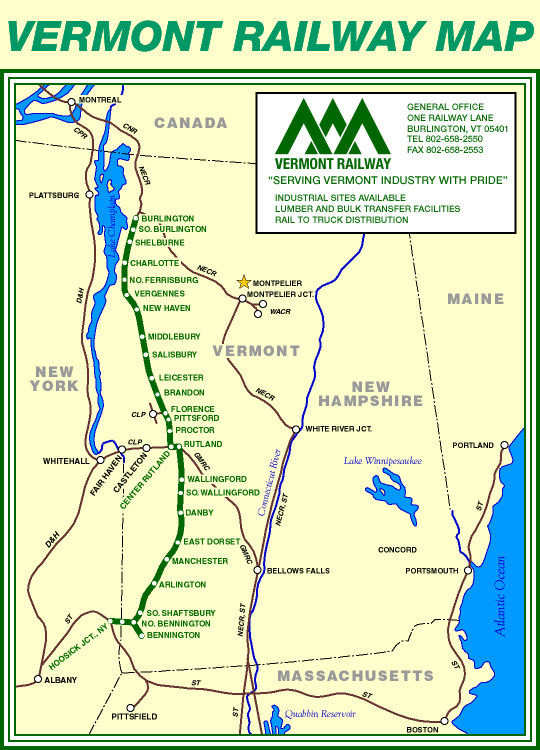
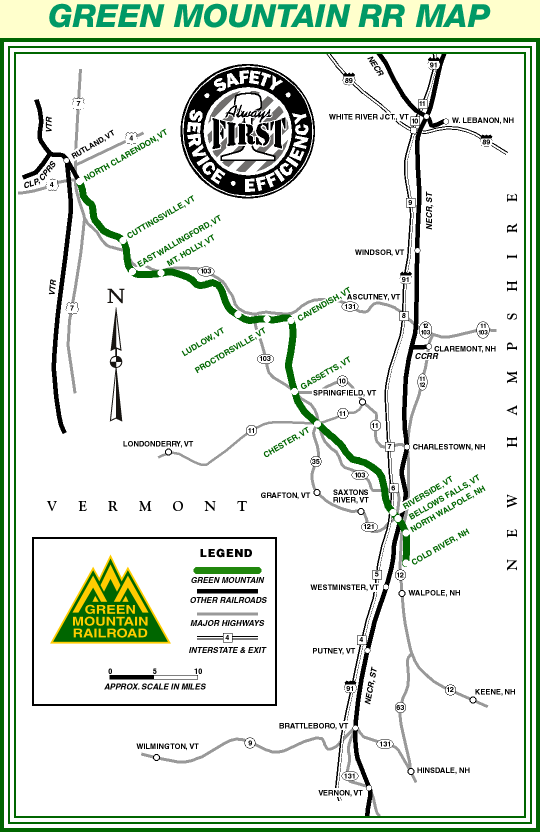
The Vermont Rail System (VRS) operates the existing Rutland Railroad property in Vermont, plus routes of several other railroads including Delaware & Hudson and Boston & Maine in New York and New Hampshire. The Vermont Rail System consists of five railroads: Clarendon & Pittsford Railroad, Green Mountain Railroad, New York & Ogdensburg Railway, Vermont Railway and Washington County Railroad. The company also has a number of other ventures that support the railroad. For example, there is the Walpole Railcar Repair facility which conducts railcar inspections, maintenance and repairs for various car owners. Additionally, VRS has what it calls VRS-Connect, a network of companies working with the railroad to provide transload, warehousing and distribution options along and near the railroads.
The Vermont Rail System began with the creation of the Vermont Railway in 1964. The railway took over the operations of former Rutland Railway trackage between Bennington and Burlington, all bought by the State of Vermont. One of the best known ventures of the Vermont Railway was its fleet of intermodal trailers. Starting in 1967, the railroad began a push for shippers to use trailer-on-flat-car services. Operating nationwide, the Vermont Railway had at one time more than 6,000 trailers and became one of the largest trailer operators in the country. This volume of equipment gave the railroad a major role in the development of intermodal equipment. Demand for the service led the company to have terminals in Chicago, St. Louis and Memphis.
In the Vermont area, the company grew more when it acquired the Clarendon & Pittsford Railroad in 1972, and then the former D&H line west out of Rutland to Whitehall, New York in 1983. After many years of independent operations, the Green Mountain Railroad was acquired in 1997. The ownership of several different railroads forced the creation of a holding company - the Vermont Rail System. This umbrella organization allowed the various railroads to be kept legally separate, but to allow a means of general control and sharing of talent and assets. Over the next decade, the Vermont Rail System also gained control of the Washington County Railroad and the New York & Ogdensburg Railway.
As the company states, "Today, while maintaining its family ownership, the 150 employees of the Vermont Rail System operate 350 miles of railroad running freight and passenger trains and support reload and warehouse facilities at multiple locations along our lines. The synergy of these divisions has developed the Vermont Rail System into a complete logistics provider."
In 2014, the Vermont Rail System celebrated its 50th anniversary by holding a number of events across the railroad. As a part of the celebration, the railroad repainted locomotive 311, a rebuilt GP40-2LW. This locomotive is the first locomotive to wear the full Vermont Rail System name, and was named after founder Jay Wulfson's wife, Joan Wulfson. The locomotive is easy to identify in a crowd with its bright red body and gold-painted trucks.
MP
39.49 East Wallingford -
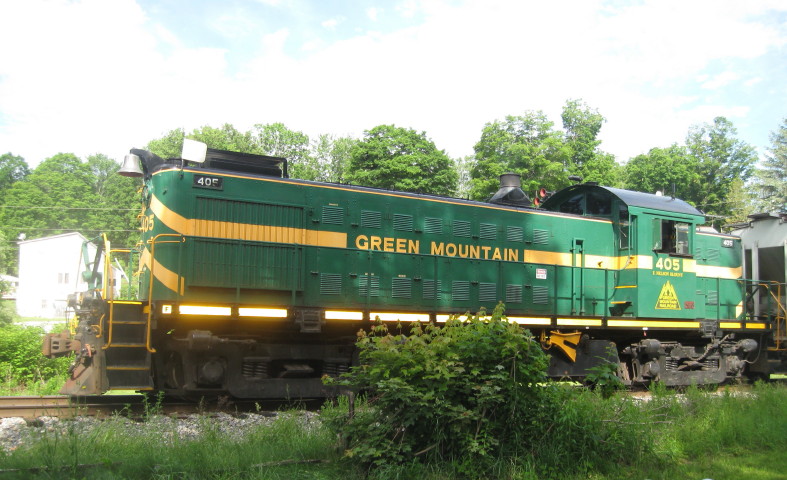
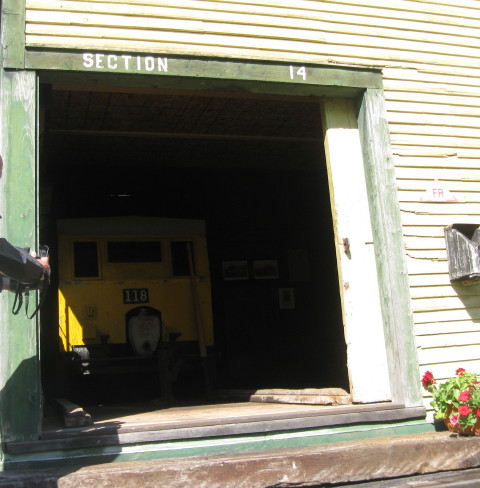
A former Rutland Railroad section house, built
in 1877, has been restored and moved up the tracks about 150
feet to a new location on private property, now part of the
Wallingford Historical Society.
Green Mountain Railroad 72 seat coach 1319, ex. New Jersey Transit 5151, nee Central of New Jersey, built by Pressed Steel in 1931.
Green Mountain Railroad table car 1313, nee Central of New Jersey 1313 built by Pressed Steel in 1931 on end.Green Mountain coach 1317, nee Central of New Jersey
1317, built by Pressed Steel in 1931. It was rebuilt
with a control cab on one end to allow push-pull
operations.
Green Mountain Railroad 72 seat coach 1319, ex. New Jersey Transit 5151, nee Central of New Jersey, built by Pressed Steel in 1931.
Next door neighbor.
After uncoupling the passenger cars, the empty freight cars are drop off at MP 25.47 Smithville - at the Imerys Talc America facility. Afterwards 405 ran around the passengers cars and now heading in opposite direction. The front end now became the end.
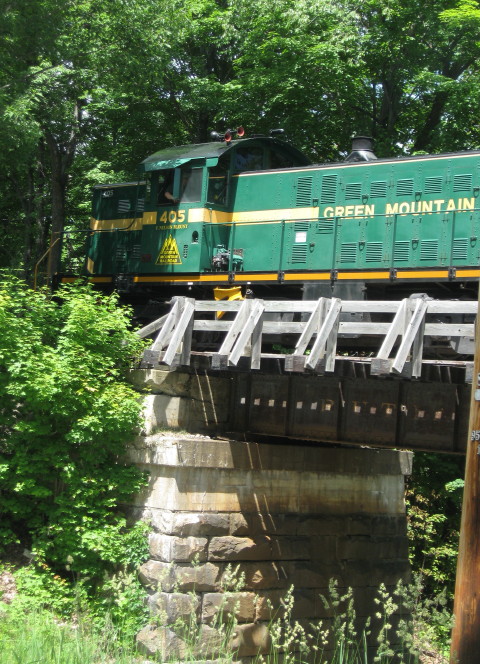
After out train ride, Chris and I jump in to our car and head to Proctor, VT for our first stop at Wilson Castle.
Wilson Castle
is a three-story house, home to five
generations of the Wilson family. Located on
ta 115-acre estate, the house was built in the
middle of the 19th Century with a unique style
and design. Today, part of the estate is owned
by the Wilson Foundation, Inc., a non-profit
organization with the goal of preserving the
complex.
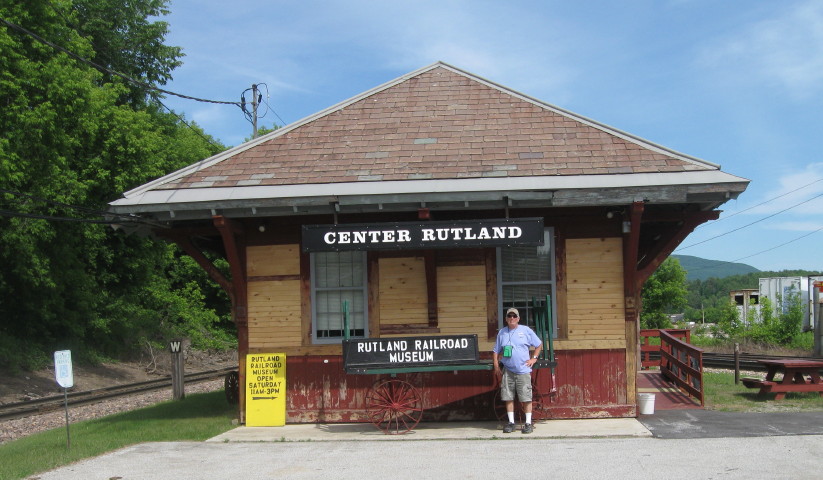
GMTX GP38 2663, ex. Locomotive Leasing Partners 2039, exx. CSX 2117, nee Baltimore and Ohio 4817 built by Electro-Motive Division in 1970. We drove south on Vermont Highway 7.
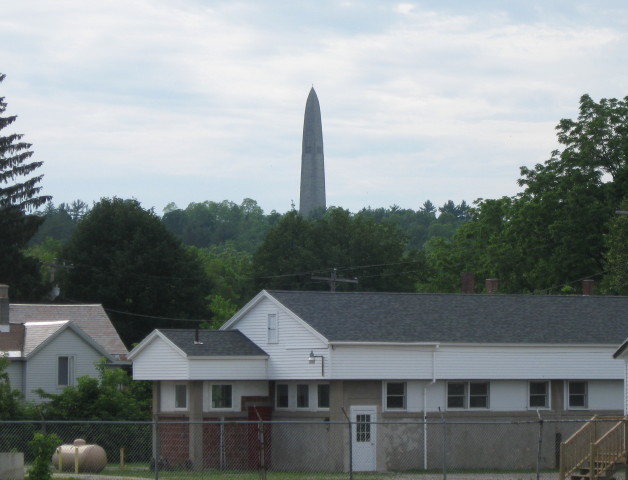
The Bennington Battle Monument is 306 feet 4 and 1/2 inches tall and was completed and dedicated in 1891. It is constructed from blue-grey magnesium limestone.
The Monument was built to commemorate the Battle of Bennington which occurred on August 16, 1777, and is considered to be the turning point in the Revolutionary War.The Boston & Maine Eagle Bridge station built in 1891. Next we drove to Cambridge.
Cambridge Batten Kill Railroad station built in 1900 by the Delaware and Hudson Railroad.
Cambridge Batten Kill freight station built in 1853 by the Delaware and Hudson.
The Eagleville Covered Bridge built
in 1858 by Ephraim W. Clapp and
crosses the Batten Kill River.
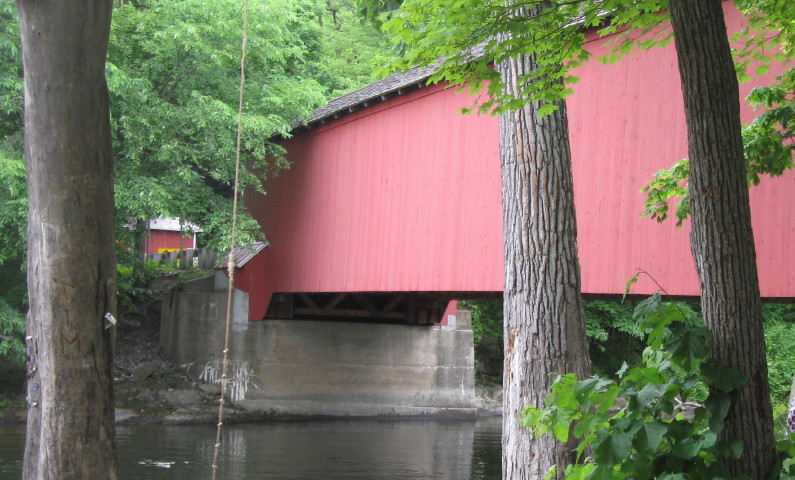
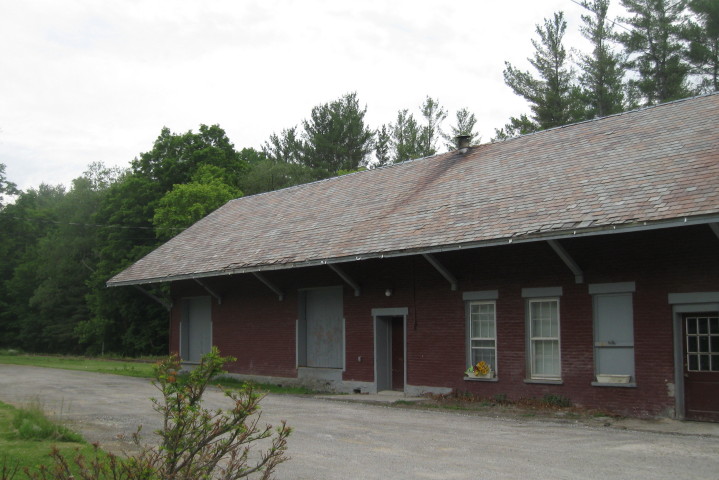
The Shushan Batten Kill Railway station built in 1887 by the Delaware and Hudson. From here we drove back into Vermont and before reaching Arlington, we took Covered Bridge Roa0d.
Arlington Green Covered Bridge built in 1852. Next we drove into Arlington.
